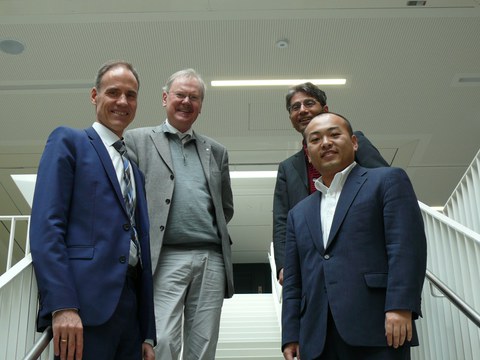Apr 10, 2019
Japanese company visits TU Dresden

Clockwise beginning at the bottom left: Dr. Konrad Crämer, Prof. Dr. Johann-Wolfgang Bartha, Akimitsu Fujii, Yoshiyuki Fuhjishiro
On 13 March 2019, a cooperation meeting took place between the Japanese company RORZE, the Saxony Economic Development Corporation and the Transfer Office of the TU Dresden. RORZE specializes in automation systems for the transfer of semiconductor wafers and liquid crystal glass substrates. The robots and systems are used in production lines for semiconductor components that are installed in various electronics. In addition, the cell culture devices for iPS cells, etc., which are to prove useful in many applications in the medical field, are currently used in university laboratories and in pharmaceutical companies. The Japanese company holds more than 40 patents related to the automation and clean substrate handling of wafers, LCD substrates and particle reduction. RORZE employs more than 2000 people and sells its products worldwide, including for Infineon.
The reason for the cooperation meeting was the company's plans to open a service and sales location in Dresden in order to be able to communicate directly with its customers in Europe as well. In a specialist lecture Prof. Dr. Johann Wolfgang Bartha (Chairholder of Semiconductor Technology) presented the main research areas of the Faculty of Semiconductor and Microsystems Technology and answered technical questions from RORZE Chief Executive Officer Yoshiyuki Fuhjishiro and the office manager Akimitsu Fujii. The company was interested in joint research projects with the TU Dresden and plans to offer internships of several weeks for TU students in Japan. Mr. Fuhjishiro emphasized the excellent research and development possibilities in Dresden, which result from a close network with strong partners from science and culture in the context of Dresden concept, and which create various cooperation possibilities for the company.
The research and development work of the global company shows many intersections with the research fields of the TU Dresden, so that further discussions are planned. The Transfer Office coordinates further cooperation and communication and enables scientists and companies to establish strategic cooperations and jointly develop and exploit research and development results.
